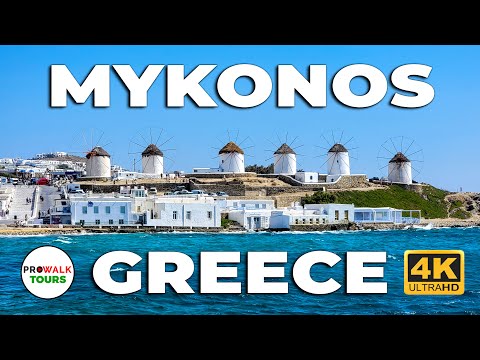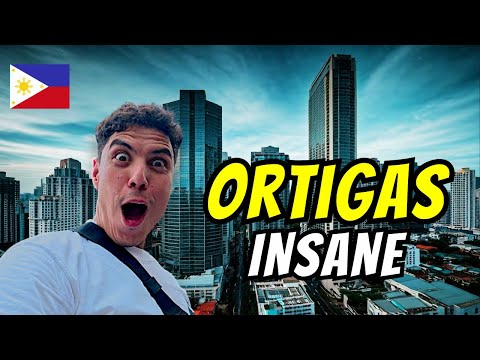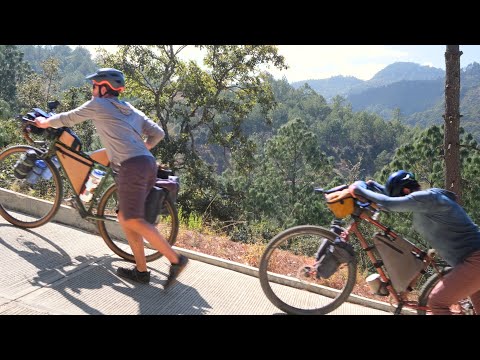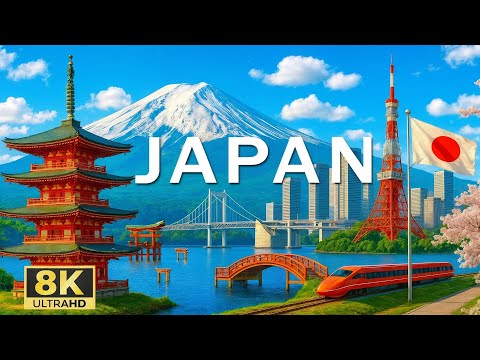Mykonos, Greece Daytime Walking Tour - 4K - with Captions

Welcome to Mykonos, a Greek island in the Aegean Sea. The capital town of the island is also called Mykonos, and for this reason, the old town is also known as Chora, meaning "the town" in Greek. Mykonos is part of an island group called the Cyclades which includes about 220 islands. The name Cyclades refers to the islands forming a circle around the sacred island of Delos. Most of the smaller islands are uninhabited. Mykonos has an area of about 33 square miles (85.5 km²) and rises to an elevation of 1,119 feet (341 meters). Mykonos's nickname is "The Island of the Winds", due to the very strong winds that blow year round on the island.
There are unfortunately some moments with very loud wind noise during this walk. Just be prepared to mute the audio at times. Furthermore, the winds are at their strongest during July and August, especially during the afternoon and early evening. We are at what is now the Old Port of Mykonos, with the new port located on the opposite side of the bay where that giant cruise ship is located.
Most visitors arrive to the island by cruise ship or ferry although there is an airport on the island with short flights from Athens. There is a small water taxi that takes visitors from the new port over to this side of the bay. You do not need to walk the entire way with your luggage. :) The taxi makes two stops, one right where this walk began, and another near the small church which we will see here shortly. This is the central piazza of the old port, Manto Square, and at its center is a statue of Manto Mavrogenous: the legendary Dame of Mykonos.
Manto was born in Trieste, Italy in 1796, the daughter of a Greek Merchant. Her mother was born in Mykonos. For nearly 400 years, the Turks had occupied Mykonos and Manto played a significant role in the Greek Revolution of 1809. We will see her statue in just a bit, but first we will take a stroll down the waterfront. Manto spent every penny of her fortune supporting the Greek cause.
Here in Mykonos, she is still honored for her courage, integrity and strength. The island has a population of around 12,500 residents and most live here in the old town of Chora. There are two seasonal winds here in Mykonos. The summer winds, coming from the north, are known as the Meltemi. The winter winds, coming from the south, are known as the Sirocco.
This is the fish market, designed to look like old sailing ship. It comes alive in the early morning when the days catch arrives. At the end of the Old Port is a church dedicated to St. Nikolaos, the patron saint of sailors, fishers, and merchants with Greek ancestry. St. Nikolaos died around 343AD, and this church was built during the 4th century, making it a very early dedication.
The pier up ahead is where the water taxi makes it second stop here at the old port. Nikoloas was fired as a Bishop after slapping ‘heretical’ Deacon Arius at the Council of Nicaea in 325. He was made a saint for reportedly resurrecting three dead boys and for giving anonymous gifts to those in need.
These stories combined inspired the Dutch legend of Sinterklaas, who gave presents to kids on Saint Nikoloas’ Day- December the 6th. Eventually the story of Saint Nikoloas merged with that of Father Christmas from Britain and became Santa Claus. The building straight ahead is the Mykonos Town Hall. We are now heading back to the piazza where we will make our way into the center of town with a stop at a couple of windmills up on the hill ahead. In 2018, Greece broke all their tourism records with over 33 million visitors, which generated more than 16 billion euro in revenue for the country. Before it was a hotspot for tourists however, the island was known for its mines.
The mines were in the eastern part of the island and their goods were shipped to the world from this harbor. Baryte, which is the main source of the element Barium, is used in oil drilling, which Mykonos mined and exported en masse before tourism. The old mines are featured on many online lists of "secret attractions" on the island. Here you can see the monument dedicated to Manto Mavrogenous.
Manto used her fortune to finance and equip two ships which defeated attacking pirates during the Ottoman invasion in 1822. She often accompanied her private army of 800 men and six ships in battle, and even sold her jewelry to help survivors of the Siege of Missolonghi. Her face appeared on the 2-drachma coin from 1988-2001.
This street is named after Mavrogenous. As we walk down this narrow street you will quickly notice the colors of Mykonos, white, blue, red and green. The whitewashed walls that you see are not painted but instead covered in a layer of traditional plaster made from calcium carbonate or limestone.
Many of the houses are whitewashed up to three times a year to maintain a clean and beautiful finish. The reason for the white is simple, it keeps the homes and buildings cool because white reflects sunlight. You will also notice that the doors and shudders of the homes are painted blue, red and green. The colors were traditionally used to identify different professions on the island. Blue represented the home of a sailor while green was for farmers.
Today, local laws prohibit the use of any colors besides blue, green and red for doors and shudders. Now we are heading up to see two different windmills, known as the Pano Mili which supplied locals with rusk and flour. There are currently 16 windmills here on Mykonos, most of which were built in the 16th century. There were once a total of 28 windmills on the island which were used to grind grain into flour. Mykonos became famous as a supplier of bread and flour to all the ships passing through the Cyclades.
The wind was blowing so hard up here that I had no choice but to use audio from another walk. The island of Delos is just behind the hill you see in the background. Next, we will visit another windmill known as Boni's Windmill, which is now used as a museum that features a threshing floor, oven and wine-press. A typical windmill was three stories tall with the grinding stone located in the roof.
The grain was poured in between the stones and the flour was collected on the floor below. The ground floor of a windmill was where the weighing tables were located. The wheel of the windmill has 12 spokes attached to triangular cotton sails. Down by the water you can see another group of windmills which we'll visit later.
You can see the sails tied around the spokes here as the mill isn’t operating today. The museum is open from 4-8pm daily from June to September and free to enter....but it was closed today. In the distance you can see the island of Tinos. The red-domed church is a Church dedicated to Saint Spyridon, one of the many churches hidden among the houses. There’s a church for every 14 residents on Mykonos, explaining why most are small and local. With so many churches, some have been converted over the centuries to houses, bars and shops.
There are 60 churches in Mykonos Town (Chora) alone and over 600 in total on the island. In fact, there is said to be as many churches on the island as there are families. While you may hear locals speaking Greek, everyone that I talked with also spoke English very well. Most of the churches were constructed as centerpieces for the annual summer Paniguria festival in honor of the Virgin Mary. During the festival, locals begin at a church with a morning feast, followed by music, food, wine, and dancing. Churches were often built on the site where a miracle had occurred in Orthodox faiths.
Furthermore, islanders still build small chapels and churches as shrines to house the bones or relics of departed family members. This is Florou Zouganeli Street, a narrow road with trendy independent shops. Many are boutiques selling high end fashion. Boutique derives from the Greek word for storehouse. While there are many boutiques, galleries, cafes and souvenir shops to browse around, my favorite part was just wandering through the pedestrian maze of narrow streets.
We are about to return to Manto Square and then turn back into the historic center and walk down the retail and nightlife hub of the island, Matogianni Street. Besides the town itself, the main attractions in Chora are the windmills, the neighborhood of Little Venice, the Panagia Paraportiani church and Petros the Pelican. Petros the Pelican is the town mascot and can sometimes be seen wandering the streets. Local legend says that Petros was brought to the island by a fisherman in the 1950’s who found him injured at sea Petros stayed in town after his recovery, becoming a celebrity. He became the official island mascot in 1958. Petros was photographed with the glamourous visitors to the island through the 60’s and 70’s.
Petros was even given his own house to protect him from the winds and low temperatures. Unfortunately, after 33 years of wandering the island, Petros died in 1985 after being hit by a car. The entire island went into mourning after he died.
This caught the attention of one of the most famous visitors to Mykonos, Jackie Kennedy-Onassis. Jackie O came to the rescue and donated a new pelican named Irene to the island. The Hamburg Zoo also decided to help out and gave the island another young male pelican, which inherited the name of Petros. The house on the right with the red doors and a cannon out front is Lena's House Folk Museum and the Aegean Maritime Museum. Lena’s House (with the red windows and doors) is a preserved 19th century home, full of period furnishings down to cooking utensils and clothing.
The Maritime Museum is in the former house of merchant Nikolaos Sourmelis. He used his ship to support Crete’s revolt against the Ottomans from 1866-69 The maritime museum features ancient amphorae from shipwrecks, models of boats, and classical Greek coins showing naval scenes. The museum is only open in the mornings, and charges a small entrance fee.
Several years later, another wounded pelican found itself in Mykonos and locals cared for it as well. Today, there are at least three "Petros the Pelican" that can be seen wandering around the island. In Greek, the word “petro” means stone or rock, but can also mean grumpy and old. We are now going to head out to the water to see the "Windmills of Mykonos." It is going to be windy! Just a warning for you. This waterfront neighborhood is known as Little Venice. I don't see the resemblance. Do you? :)
Their sign says they sale Cuban cigars. While there are other windmills on the island, this group are known as ‘The Windmills of Mykonos.’ These windmills once supplied the passing ships with flour which made Mykonos a popular destination in the area. The name “kato mili” means “the mills down below” as they are down by the water near the port of Alefkandra. Most of the windmills on the island were built by the Venetians in the 16th century, but their construction continued into the early 20th century.
Such windmills are found in almost all Cyclades islands. The windmills are no longer operational, but they continue to be a symbol of Mykonos rich virile past. It is clear why the windmills were placed at this location. This area is the most popular spot on the island to watch the sunset. This small beach is Alefkandra beach.
We are now going to walk along the water and over into the Little Venice neighborhood. The homes along the water were built in the 18th century and originally belonged to rich merchants and ship captains. Many of these homes have now been transformed into bars, restaurants and nightclubs. This is the Church of Zoodochos Pigi, called Megali Panagia by locals and the Metropolitan Church by Google maps.
The church was built in the 17th-century and is the Orthodox Cathedral of Mykonos. Inside the church, the apse walls are painted red and decorated with framed paintings. The ceiling shows scenes from the life of Jesus painted in blue, red and yellow. It’s thought the church is named for a religious icon of Mary found down a well on this site, as Zoodochos means ‘life giving’ and Pigadi means ‘well.’ Here at Cine Manto, you can enjoy some food and wine while you watch an outdoor movie. Cinema tickets are very reasonable, Adults €9 and Children €7. The menu is fair too (octopus salad €12), but consists largely of salad in some form.
Mykonos is not a fast food, burger, fries, and curry sauce type of island. The only food chain on the island is Starbucks. According to Greek mythology, the island was thought to have got its name from the Mykonos, the first ruler who was believed to have been a descendent of the Greek god Apollo. In Greek mythology ,the island was said to have been formed after Hercules defeated giants and their bodies petrified into large rocks which became the island.
Throughout ancient history, the nearby island of Delos was the most powerful and most populated island in the area. Mykonos was a relatively poor island in comparison. Ironically, Mykonos is now one of the most popular islands in Europe and Delos, now an archaeological site, is an optional day trip for tourists with extra time. We are now walking back towards the waterfront bar in Little Venice.
Mykonos was under the rule of the Roman Empire and then eventually became part of the Byzantine Empire. This is the site of an old church now in ruins. The original name of the Little Venice neighborhood was Alefkandra, but with the increase in tourism in the mid-1900s, authorities decided to change the name for a more romantic feel. Mykonos remained a relatively poor island until the mid 1950's when the bohemians and artists first arrived. Royalty and A-list celebrities were among those who first discovered the island on their vacations sparking a wave of tourism that continues today. From this port you can catch a ferry to Delos for €20 and visit the ancient remains of the once great city.
Jackie Onassis often visited the island which inspired the names of many tourist spots, including this café on the left. The building with the red balcony is the Mykonos Folklore Museum which is similar to Lena’s house. Exhibits include cannons from the Greek revolutionary war. On the right are the ruins of a 17th century castle, which gave the Church of Panagia Paraportiani or ‘Mary Next to The Door’ its name. Construction of the church began in 1425 and construction continued until the 17th century. This is actually one church with 4 different chapels all built on the same site with Agios Efstathios at the center and the chapels of Agia Anastasia, Agios Sozon, and Agios Anargyros around the outside. The church is rarely open to the public but the outside is still interesting to see.
The front door to the church was open early in the day and I took a peak inside. It just looked like a empty, gutted out, stone room with a dirt floor. There was no color or objects inside. Now we are going to walk back through Little Venice and head up to the town bus station where you can also rent 4-wheelers and mopeds. A joke among residents of Mykonos is that if a tourist asks for directions, their destination is always “next to the white house with the blue windows.” The local architecture is the same out of necessity. White stops buildings getting too hot and the cubic shape means less construction materials are needed. Houses face south to avoid the northern wind mentioned earlier, and the blue and white color scheme was law from 1967 to 1974. The colors were deemed patriotic by the military dictatorship, and though rules were relaxed after its collapse, blue and white had become fashionable.
In 1961, an urn was found at the bottom of a well, dating back to 675 BC, with a depiction of the Trojan Horse. Sometimes when I'm traveling, I do a little magnet fishing in old wells. I have yet to find anything. :) Someday though..someday! Some economists worry Mykonos is becoming culturally dependent on tourism. This means locals lose control of decision making and tourist interests are prioritized instead. I enjoy visiting places like this, but I definitely enjoy visiting places where there is little to no tourism much more. There is a lot of history and beautiful places to see, but none of it feels very real. I suppose it all depends on why you want to be here.
2021-10-18 00:59


